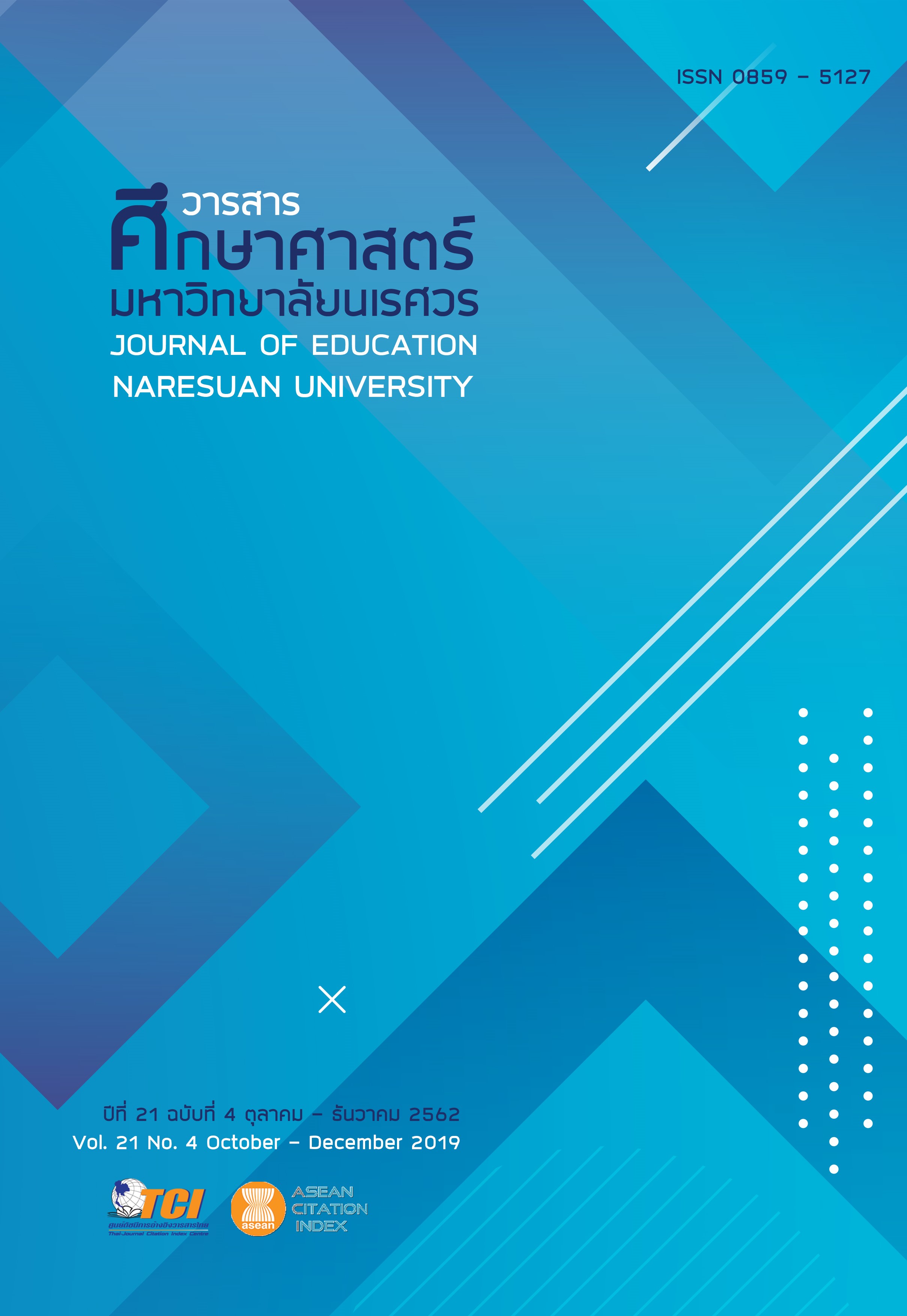การพัฒนารูปแบบการเรียนรู้แบบร่วมมือในแหล่งเรียนรู้ชุมชน ด้วยเทคโนโลยีบาร์โค้ดสองมิติ (THE DEVELOPMENT OF COLLABOLATIVE EXCURSION LEARNING MODEL IN COMMUNITY RESOURCES BY USING TWO-DIMENTIONAL BARCODE TECHNOLOGY)
Main Article Content
Abstract
การวิจัยครั้งนี้มีวัตถุประสงค์เพื่อ 1) เพื่อศึกษาองค์ประกอบที่สำคัญสำหรับการพัฒนารูปแบบการเรียนแบบร่วมมือในแหล่งเรียนรู้ชุมชนด้วยเทคโนโลยีบาร์โค้ดสองมิติ 2) เพื่อสร้างและหาประสิทธิภาพของรูปแบบการเรียนรู้แบบร่วมมือในแหล่งเรียนรู้ชุมชนด้วยเทคโนโลยีบาร์โค้ดสองมิติ 3) เพื่อเปรียบเทียบผลสัมฤทธิ์ทางการเรียนหลังเรียนกับคะแนนก่อนเรียน 4) เพื่อประเมินรับรองรูปแบบการเรียนแบบร่วมมือในแหล่งเรียนรู้ชุมชนด้วยเทคโนโลยีบาร์โค้ดสองมิติ เครื่องมือที่ใช้ ได้แก่ 1) แบบประเมินความเหมาะสมของรูปแบบ 2) แบบวัดผลสัมฤทธิ์ทางการเรียน 3) แบบวัดประสิทธิภาพรูปแบบการเรียน 4) แบบประเมินความพึงพอใจสำหรับผู้เรียน และ 5) แบบประเมินรับรองรูปแบบการเรียนสำหรับผู้ทรงคุณวุฒิ ผลการวิจัย พบว่า
1. องค์ประกอบรูปแบบการเรียน 8 องค์ประกอบ ได้แก่ 1) หลักการและทฤษฎี 2) วัตถุประสงค์ 3) เนื้อหา 4) การเรียนแบบร่วมมือ 5) กิจกรรมการเรียนการสอน 6) สื่อและเทคโนโลยี 7) แหล่งเรียนรู้ 8) การวัดและประเมินผล และการประเมินความเหมาะสมขององค์ประกอบของรูปแบบการเรียนแบบร่วมมือในแหล่งเรียนรู้ชุมชนด้วยเทคโนโลยีบาร์โค้ดสองมิติ มีความเหมาะสมในระดับมากที่สุด ( = 4.55, S.D. = 0.05)
2. ประสิทธิภาพของรูปแบบการเรียน 86.29/83.81 สูงกว่าเกณฑ์ที่ตั้งไว้เท่ากับ (80/80)
3. ผลสัมฤทธิ์ทางการเรียนหลังเรียนสูงกว่าคะแนนก่อนเรียนอย่างมีนัยสำคัญทางสถิติที่ระดับ .01
4. ความพึงพอใจของผู้เรียนอยู่ในระดับมาก ( = 4.53, S.D. = 0.20)
5. ผลการรับรองรูปแบบโดยผู้ทรงคุณวุฒิมีความเหมาะสมในภาพรวมอยู่ในระดับมาก ( = 4.46, S.D. = 0.14)
THE DEVELOPMENT OF COLLABOLATIVE EXCURSION LEARNING MODEL IN COMMUNITY RESOURCES BY USING TWO-DIMENTIONAL BARCODE TECHNOLOGY
The purpose of this research was 1) to study the component for the development of collaborative excursion learning model in community resources by using two-dimensional barcode technology, 2) to create and find the efficiency of the collaborative excursion learning model in community resources by using two-dimensional barcode technology, 3) to compare the learning achievement between before and after learning, 4) to evaluate the satisfaction of collaborative excursion learning model in community resources by using two-dimensional barcode, and 5) to evaluate the acceptation of experts the development of collaborative excursion learning model in community resources by using two -dimensional barcode technology. The research tool was 1) the propriety standards of model, 2) learning achievement test, 3) the efficiency of learning model, 4) learning satisfaction, and 5) the model acceptance by experts. The research found that:
1. The eight components for learning model were 1) principle and theory, 2) objectives, 3) content, 4) learning model, 5)media and technology, 6) measurement, 7) community resources and 8) evaluation and the quality of the component for the development of collaborative excursion learning model in community resources by using two-dimensional barcode technology at high level ( = 4.55, S.D. = 0.05).
2. The efficiency of collaborative excursion learning model in community resources by using two-dimensional barcode technology at 86.29/83.81 which was higher than criterion standard (80/80).
3. The after learning achievement was statistically higher than before learning at 0.5 level.
4. The learning satisfaction of learners at high level ( = 4.53, S.D. = 0.20).
5. The model acceptance of experts were at high level ( = 4.46, S.D. = 0.14).
Article Details
The owner of the article does not copy or violate any of its copyright. If any copyright infringement occurs or prosecution, in any case, the Editorial Board is not involved in all the rights to the owner of the article to be performed.
References
2. Brahmawong, C. (1977). The educational innovation and technology for pre-elementary school. Bangkok: Thai Wattanapanich. [in Thai]
3. Chaboonmee, S. (2010). Developing mathematics learning activities entitled “Whole Numbers” for Mathayomsuksa I students by using student teams achievement (Master thesis). Maha Sarakham: Rajabhat Maha Sarakham University. [in Thai]
4. Chantanarungpak, K. (2005). Development of web-based instruction model blended with cooperative learning in mathematics for upper primary school students (Master thesis). Bangkok: Chulalongkorn University. [in Thai]
5. Dachakup, P. (2001). Child-centered learning: Method and teaching technic 1. Bangkok: The Master Group Management. [in Thai]
6. Jaitieng, A. (2007). Teaching principle (4th ed.). Bangkok: Odian Store. [in Thai]
7. Munkham, S., & Munkham, O. (2010). 19 methods of learning management: To develop the thinking processes (9th ed.). Bangkok: Parbpim Printing. [in Thai]
8. National Institute of Technology for Education. (2010). National Education Act B.E.2542 (1999) and Amendments (third National Education Act B.E. 2553 (2010). Bangkok: Pimdee. [in Thai]
9. Onthanee, A. (2009). The development of the instructional model to enhance learning facilitator’s competence based on knowledge management approach for teacher students. Journal of Education Naresuan University, 11(special), 33 – 52. [in Thai]
10. Sangesri, T., & Suraporn, B. (2017). A study of learning achievement in mathematical problem solving process skill using polya’s problem solving process with STAD Technique. In The 22nd Annual Meeting in Mathematics (AMM 2017) Department of Mathematics. Chiang Mai: Lotus Pang Suan Kaew Hotel. [in Thai]
11. Sariwat, L. (2014). Educational psychology. Bangkok: O.S. Printing House. [in Thai]
12. Sharples, M., Taylor, J., & Vavoula, G. (2007). A theory of learning for the mobile age. In R. Andrews and C. Haythornthwaite (eds.). The Sage Handbook of E-learning Research. (pp. 221-247). London: Sage.
13. Singchu, K. (2009). Internet lesson development information technology course using a cooperative learning model STAD for Mathayom Suksa 4 students (Master thesis). Phitsanulok: Naresuan University. [in Thai]
14. Thitichaikawin, D. (2016). Development of curiosity instructional model for lower secondary school student, the non-formal and informal education center, Chonburi province (Doctoral dissertation). Chonburi: Burapha University. [in Thai]


